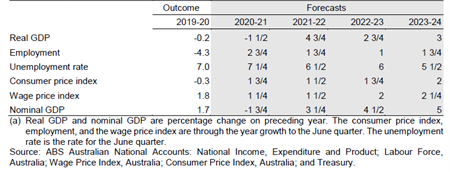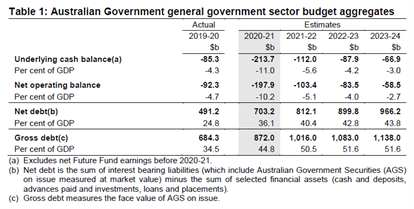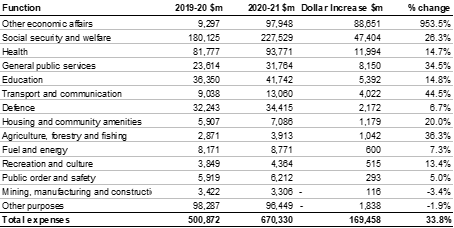At the end of World War II, Ben Chifley saw a vision of a powerful Australian economy recovering from years of pain. His vision was enacted first by his government and then for many years by the governments of Robert Menzies. Not since Chifley, has there been a vision of Australian national recovery on a scale such as now contemplated by Scott Morrison and Josh Frydenberg.
Figure 1: Major economic parameters

Advertisement
SOURCE: Budget Paper No 1: 2020-21, Table 2: Page 1-8
The Treasurer expects that Australian GDP will fall by 3.75% in calendar 2020 and rise by 4.25% in calendar 2021. This compares to our most recent estimates of a fall of 3.5% in calendar 2020, followed by a rise of 4.0% in calendar 2021. Our outlook and that of the Australian government, are consistent with that of the Federal Reserve for the US economy.
These growth rates on a financial year basis translate into a decline of 1.5% in 2020-21 and growth of 4.75% in 2021-22. The government expects this will be followed by growth of 2.75% in 2022-23. This is followed by a growth of 3.0% in 2023-24.
Unemployment rises to 7.25% in mid 2021, before declining to 6.5% in mid 2022, then 6.0% in mid 2023, and 5.5% in mid 2024. We said last week that the RBA would continue quantitative easing until unemployment fell to 4.5%. This would now appear to not occur until some time after 2024. We see that nowhere in the outlook until mid 2024 does Australian inflation rise to the RBA target of between 2% and 3%.
In Figure 2 below, we see the Australian General Government sector aggregates. A powerful program of recovery is supported by a powerful program of fiscal stimulus not seen since World War II. A deficit of 4.3% of GDP is followed by a deficit of 11% of GDP in 2020-21. This then declines in 2021-22 to 5.6% of GDP. It then eases in 2022-23 to 4.2% of GDP. It then declines further in 2023-24 to 2.7% of GDP.
The result is that Australian Government net debt to GDP rises from 24.8% of GDP in 2019/2020 to 43.8% of GDP in 2023-24. Although these debt levels are very high numbers in Australian terms, they are far below what will be experienced by the United States and the United Kingdom.
Advertisement
Figure 2: Budget aggregates

SOURCE: Budget Paper No 1: 2020-21 Table 1: 3-6
The programs described in Frydenberg's speech are both large and historic. He notes that Jobkeeper is a $101 billion program, supporting 3.5 million jobs. This program has helped some 800,000 small and medium businesses to remain in business. Jobseeker doubled the safety net. Together, these actions have saved 700,000 jobs.
JobMaker now begins. The JobMaker hiring credit will be payable for up to 12 months and available to employers who hire those on JobSeeker aged from 16 to 35. This will support 450,000 jobs for young people. An additional $1.2 billion will create 100,000 new apprenticeships and traineeships with a 50% wage subsidy for businesses who employ them.
From Budget Night, over 99% of businesses will be able to write-off the full value of any eligible asset they purchased for their business. This will be available for small, medium and larger businesses for a turnover of up to $5 billion, until June 2022.
The Treasurer notes that this will dramatically expand productive capacity of the nation and create tens of thousands new jobs. These programs and others generate a dramatic expansion of the Australian budget deficit that we can see in Figure 3 below. These deficits only gradually decline over the next decade. Still, they generate enormous support for a broader Australian recovery.
Figure 3: Underlying cash balance as a share of GDP

SOURCE: Budget Paper No 1 Statement No 3 Fiscal Strategy and Outlook – Chart 4 - Page 3-28
Where the money goes
In Figure 4below, we see expenditure outlined in Budget Paper No.1: Budget Strategy and Outlook 2020-21; Statement 5, Expenses and Net Capital Investment. This Budget proposes to spend a total of $670.3billion. The largest section of spending by far remains Social Security and Welfare. This will consume $227.5billion or 34% of total spending. Health expenditure consumes $93.8 billion or 14% of total spending. Education comes next with $41.7 billion or 6.2% of total spending. Only then do we find Defence with $34.4 billion or 5.1% of total spending.
Figure 4: Estimates of Australian General Government Expenses by Function

SOURCES: Budget Paper No.1: Budget Strategy and Outlook 2020-21 Statement 5, Expenses and Net Capital Investment; Morgans
In Figure 5below,we see the dollar increases in Australian government spending by sector. We calculate these as the increase in the budget for 2020-21 over the budgeted expenditure a year ago in the Budget for 2019-20. Expenditure on Social and Welfare increases by $47.4 billion. Health spending rises by $12.0 billion. Education rises by $5.4 billion. Transport and Communication rises by $4.0 billion.Then comes Defence which rises by $2.2 billion.
Figure 5: Estimates of Increases in Australian General Government Expenses by Function

SOURCES: Budget Paper No.1: Budget Strategy and Outlook 2019-20 & 2020-21 Statement 5, Expenses and Net Capital Investment; Morgans
What this Budget does
Not since Chifley, has there been a vision of Australian national recovery on a scale such as now contemplated by Scott Morrison and Josh Frydenberg. A $1.3 billion modern manufacturing plan will target six national manufacturing priorities:
Food and beverage manufacturing;
Resources technology and critical minerals processing;
- Medical products;
- Recycling and clean energy;
- Defence industry and
- The space industry.
Together with what the government has announced since the start of the crisis, measures in this Budget will see $14 billion in new and accelerated infrastructure projects that will support a further 40,000 jobs.
The Treasurer announced $2 billion in new funding to build water infrastructure across the country as part of our national water grid including dams, weirs and pipelines.
In this Budget, the government provides $2 billion in additional Research and Development incentives – removing the cap on refunds, lifting the rate and rewarding those businesses that invest the most.
The government is also providing:
- $459 million in additional funding to the CSIRO;
- $1 billion for new research funding for our universities, backing our best and brightest minds whose ideas will help drive our recovery;
- $1.9 billion in new funding as part of our energy plan to support low emissions and renewable technologies, helping to lower emissions and address climate change.
The Government's COVID-19 vaccine and treatment strategy supports early access to, and delivery of, safe and effective COVID-19 vaccines and treatments as soon as they become available. The Government will provide $1.7 billion over two years from 2020-21 to secure access to over 84.8 million doses of potential vaccine candidates developed by the University of Oxford and the University of Queensland.
Conclusion
The document that was presented by Josh Frydenberg is much more than an annual Budget. It is a multi-year program for national recovery. The breadth of its conception and its potential for long term benefit for the Australian economy is the greatest of any set of programs since those introduced to establish and expand Australian manufacturing at the end of World War II.
It is obvious that this government has spent some time developing this program on recovery and development. The discussion of this program is much greater that can be covered in a single document.
This article was first published by Morgans.
The information contained in this report is provided to you by Morgans Financial Limited as general advice only, and is made without consideration of an individual’s relevant personal circumstances. Morgans Financial Limited ABN 49 010 669 726, its related bodies corporate, directors and officers, employees, authorised representatives and agents (“Morgans”) do not accept any liability for any loss or damage arising from or in connection with any action taken or not taken on the basis of information contained in this report, or for any errors or omissions contained within. It is recommended that any persons who wish to act upon this report consult with their Morgans investment adviser before doing so. Those acting upon such information without advice do so entirely at their own risk.
This report was prepared as private communication to clients of Morgans and is not intended for public circulation, publication or for use by any third party. The contents of this report may not be reproduced in whole or in part without the prior written consent of Morgans. While this report is based on information from sources which Morgans believes are reliable, its accuracy and completeness cannot be guaranteed. Any opinions expressed reflect Morgans judgement at this date and are subject to change. Morgans is under no obligation to provide revised assessments in the event of changed circumstances. This report does not constitute an offer or invitation to purchase any securities and should not be relied upon in connection with any contract or commitment whatsoever.